
Welcome to Hyperion Records, an independent British classical label devoted to presenting high-quality recordings of music of all styles and from all periods from the twelfth century to the twenty-first.
Hyperion offers both CDs, and downloads in a number of formats. The site is also available in several languages.
Please use the dropdown buttons to set your preferred options, or use the checkbox to accept the defaults.

The second movement in B minor, marked Affettuoso, is a touching trio sonata for the three soloists. Unlike the middle movement of the Triple Concerto, however, there is need for a continuo group to accompany the flute and violin when the keyboard is not playing as a soloist. Normally, of course, the one harpsichordist would do both, but here we have used both instruments to clearly separate those passages. The mood is gentle and tender, but with the sense of sorrow that often seems to come with the key of B minor.
The final Allegro is a spirited gigue with an upbeat that gives it a wonderful ‘lift’. Throughout this concerto there is no second violin part – only a small ‘ripieno’ group. Bach himself usually played the viola, but obviously in this piece was seated at the harpsichord, so his place was no doubt filled by the second violinist.
from notes by Angela Hewitt © 2005
Le deuxième mouvement en si mineur, marqué Affettuoso, est une touchante sonate en trio destinée aux trois solistes. Mais, contrairement à ce qui se passe dans le mouvement central du Triple Concerto, il est necessaire qu’un ensemble-continuo accompagne la flûte et le violon quand le clavier ne joue pas en soliste. Normalement, bien sûr, le claveciniste assumait à lui seul les deux fonctions – solo et continuo –, mais nous avons préféré utiliser deux instruments pour bien séparer les passages. L’atmosphère est douce et tendre, mais avec ce sens de la tristesse que semble souvent induire si mineur.
L’Allegro final est une gigue enjouée, avec une anacrouse qui lui confère un «allant» merveilleux. Ce concerto ne présente absolument aucune seconde partie de violon, mais seulement un petit ensemble de «ripieno». Pour cette œuvre, Bach, à l’évidence, délaissait son alto habituel pour le clavecin, le second violon faisant alors office d’altiste.
extrait des notes rédigées par Angela Hewitt © 2005
Français: Hypérion
Der zweite Satz, eine ergreifende Triosonate für die drei Solisten, steht in h-Moll und ist mit Affettuoso überschrieben. Anders als in dem Mittelsatz des Tripelkonzerts wird hier eine Continuo-Gruppe zur Begleitung der Flöte und der Violine benötigt, wenn das Tasteninstrument nicht solistisch spielt. Normalerweise würde der Cembalist natürlich beide Aufgaben übernehmen, doch hier haben wir beide Instrumente eingesetzt, um diese Passagen deutlich voneinander zu trennen. Die Stimmung ist mild und sanft doch stets mit einem kummervollen Unterton, der sich so oft in h-Moll einstellt.
Der Schlusssatz, Allegro, ist eine lebhafte Gigue mit einem erbaulichen Auftakt. In dem Konzert ist nirgends eine zweite Violinstimme notiert – nur eine kleine „Ripieno“-Gruppe. Bach selbst übernahm zumeist den Bratschenpart, doch saß er in diesem Stück natürlich am Cembalo, so dass sein üblicher Platz sicherlich von dem zweiten Geiger eingenommen wurde.
aus dem Begleittext von Angela Hewitt © 2005
Deutsch: Viola Scheffel
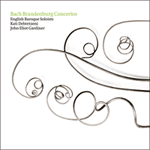 Bach: Brandenburg Concertos Bach: Brandenburg Concertos'These are undeniably Brandenburgs of flair and understanding' (Gramophone) 'The ensemble playing is a model of cohesive teamwork, but the players also shine as individuals in the many virtuoso solo passages peppered throughou ...» More |
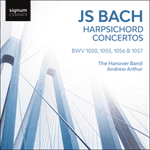 Bach: Harpsichord Concertos Nos 2, 5 & 6 Bach: Harpsichord Concertos Nos 2, 5 & 6Andrew Arthur and The Hanover Band complete their infectiously enthusiastic traversal of Bach's seven harpsichord concertos, true cornerstones of the repertoire.» More |
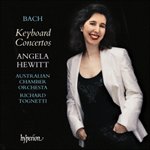 Bach: Keyboard Concertos Bach: Keyboard Concertos‘Her playing is absolutely captivating: she decorates the solo part with playful, come-hither ornamentation—twirls, flutters, arabesques—and yet it ne ... ‘Hewitt's Bach is well-known for its expressive restraint, lucid textures and rhythmic grace. These virtues are abundantly present in her thoughtful, ...» More |
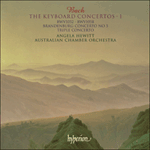 Bach: The Keyboard Concertos, Vol. 1 Bach: The Keyboard Concertos, Vol. 1‘Her [Hewitt's] playing is absolutely captivating: she decorates the solo part with playful, come-hither ornamentation—twirls, flutters, arabesques—an ... ‘Hewitt's Bach is well-known for its expressive restraint, lucid textures and rhythmic grace. These virtues are abundantly present in her thoughtful, ...» More |
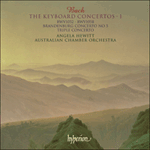 Bach: The Keyboard Concertos, Vol. 1 Bach: The Keyboard Concertos, Vol. 1 |

